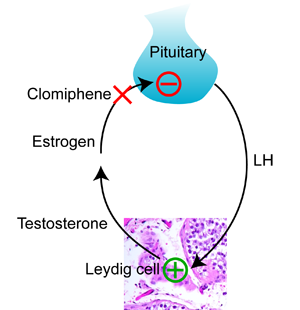April 28th, 2010 § § permalink
With the suspension of Cincinnati Reds pitcher Edinson Volquez for performance enhancing drug use and a swirl of rumors that the agent involved was clomiphene (also known as Clomid,) I thought it timely to write about how clomiphene works and how it’s used. From what I read on the internets, there is an enormous amount of misinformation floating around out there.
To understand how clomiphene works, you need to know how the pituitary controls the making of testosterone in the testis. Testosterone is made by Leydig cells in the testis, which I explained in my last post. The pituitary releases a hormone called luteinizing hormone (“LH”) that stimulates the Leydig cells to make testosterone. Testosterone is converted to the female hormone estrogen, (which I also explained in my last post,) and estrogen tells the pituitary to stop making more LH. This kind of negative feedback system is common when it comes to how hormones work. It’s just like a thermostat and heater. As the room gets warmer, the thermostat sends less electricity to the heater. When the room gets colder, the thermostat sends more electricity to the heater.
Clomiphene works by blocking estrogen at the pituitary. The pituitary sees less estrogen, and makes more LH. More LH means that the Leydig cells in the testis make more testosterone.
As I explained in my last post, giving testosterone to a man does just the opposite. The pituitary thinks that the testis is making plenty of testosterone, and LH falls. As a result, the testis stops making testosterone, and the usually high levels of testosterone in the testis fall to the lower level in the blood.
So clomiphene is a way to increase testosterone in the blood and the testis at the same time. It preserves testis size and function while increasing blood testosterone.
Unfortunately, clomiphene is not FDA approved for use in the male. Like most of the medications that we use to treat male fertility, the pharmaceutical company that originally sought approval by the FDA did it for women. Clomiphene is now generic, and it’s unlikely that anyone will pony up the hundreds of millions of dollars necessary to get it approved for the male. That’s the bad news. The good news is that it means that this medication is fairly inexpensive, cheaper than most forms of prescription testosterone. Can a doctor prescribe clomiphene for a man? Yes. It’s “off label”, meaning that it’s not FDA approved for use in men.
As a medication, clomiphene is usually well tolerated by men. In my experience, most patients don’t feel anything as their testosterone rises. Those that do feel an increase in energy, sex drive, and muscle mass, especially if they work out. Very rarely I’ve had patients report that they feel too aggressive, or too angry. Very very rarely (twice in the last 20 years) I’ve had patients report visual changes. That’s worrisome, as the pituitary is near the optic nerve in the brain, and visual changes suggests that the pituitary may be changing in size. Because the skull is a closed space, it’s alarming if anything in the brain changes in size. In the last twenty years, I’ve also had two patients who had breast enlargement (called “gynecomastia”) while using clomiphene. Needless to say, for any of these problematic side effects, the clomiphene is discontinued.
So that’s the story with clomiphene. It can be used in the male, either for fertility or low testosterone levels. It’s an off label prescription drug. It works, and is usually well tolerated by men who take it.
April 28th, 2010 § § permalink
When you think of what makes up the inside of the testes, think spaghetti. Imagine a bunch of spaghetti noodles squished together. Inside of the noodles are the developing sperm cells. Between the noodles are cells called “Leydig cells” whose job it is to make the male hormone testosterone. They start with cholesterol, and churn out testosterone.
Not only is testosterone critical to the factory inside the spaghetti that makes sperm, it is important for many parts of the male body to work well. Adequate testosterone is needed for bone and muscle strength, and men with low testosterone may experience low sex drive, problems with mental focus and depression.
The relationship between testosterone and how the penis works is less clear. Men with low testosterone can get erections, but of course sex drive can be a problem. And if a man’s testosterone is low, correcting it may improve the performance of drugs like Viagra, Levitra and Cialis.
Total testosterone doesn’t tell you the whole story. Testosterone circulates in the blood in two forms. Testosterone that is either free or loosely bound to blood protein is called “bioavailable”, and as the name implies, is available for the cells to work. Testosterone that is bound to sex hormone binding globulin (“SHBG”, but also called androgen binding protein,) is blocked from acting in cells. Although many labs offer to measure free testosterone, often the most reliable way to measure bioavailable testosterone is to have the blood tested for albumin, sex hormone binding globulin and testosterone, and then to use a calculator for bioavailable testosterone. One is available on the International Society for the Study of the Aging Male’s web site, and another for iPhones and iPod touches can be found in the iTunes store. A man may have adequate total testosterone, but still suffer from the ravages of low testosterone levels if his bioavailable testosterone is low.
Testosterone levels rise and fall during the day, with a peak in the early morning, and the lowest point in the late afternoon. That’s why many a man’s sex drive is highest in the morning, and it’s time for a nap in the afternoon.
Testosterone is converted to dihydrotestosterone, which makes the hair fall out of your hair follicles if your family tree has male pattern baldness. Dihydrotestosterone also enlarges the prostate. Drugs like finasteride (Propecia and Proscar) and dutasteride (Avodart) block the conversion of testosterone to dihydrotestosterone.
All men have a little estrogen, the female hormone. An enzyme called “aromatase” converts testosterone to estrogen. If the estrogen level is too high, it may interfere with the working of testosterone.
One last important point about the making of testosterone: levels in the testis are twenty times greater than in the blood. So if a man is given testosterone, his blood levels may increase, but the pituitary tells the testis, “hey, there’s enough testosterone around, so stop making it.” As a result, testosterone levels in the testis fall, sperm stop being made, and the testes shrink. That’s why many body builders who take testosterone and other similar chemicals experience shrinking testes. Testosterone can be great for men with low levels later in life, but for men who want to have children, it can really work against sperm production.
April 18th, 2010 § § permalink
I was at a meeting this past weekend, and one of the hottest topics of discussion was sperm shape. We call it “morphology”, and it’s how sperm look under the microscope. A technician counts up the number of normal looking sperm, and reports the percentage of the total. Here’s the odd part: with fairly generous criteria, (like normal means one oval head with one tail,) only about a third of a man’s sperm look normal. That means, for most men, most of their sperm are funny looking.
Is that a bad thing? Well, we all managed to get here with fathers that had for the most part funny looking sperm. Was it the best looking sperm that found its way into the egg and made you? That’s the million dollar question, and one for which we don’t yet entirely know the answer.
There are two ways to measure the look of sperm. One is using the World Health Organization (WHO) criteria, which for the most part say that if a third of sperm look fairly normal, the whole lot are O.K. These criteria have been around for a while, about a half century. The new kid on the block is about twenty years old, and uses a much stricter definition to call a sperm ‘normal’. Thinus Kruger invented this stricter system, and so it’s often called ‘Kruger morphology’ or ‘strict morphology’. To calculate strict morphology, the technician takes measurements of the sperm, and if any are outside the normal range, the sperm is counted as abnormal. The usual cutoff for strict morphology is 4%, which means that 95% of your sperm can be funny looking, and you’d still be considered to have normal morphology. That should give you an idea of how oddly shaped most sperm are in the typical male.
One big challenge in assessing morphology is that even though it appears to be an objective way to describe sperm shape, it still includes a great deal of subjectivity on the part of the technician. The technician is like a referee. Sometimes he or she will let a sperm pass the shape test, sometimes not. From some labs, almost no sperm are called normal in shape. So the first thing you’ll want to do if you’re told that your sperm are especially strangely shaped is to have the test repeated, preferably at a lab that does a lot of semen analyses.
For as many scientific studies that say morphology predicts how sperm do, there are those that say it doesn’t. You might think, as I did, that if a man has especially odd looking sperm, it would affect the chances of sperm getting into the egg and be a good reason to have the sperm injected into the egg using intracytoplasmic sperm injection (ICSI). ICSI is a technique used in in-vitro fertilization (IVF) where the sperm is injected directly into the egg. But in 2007, Keegan and colleagues published a study which reported that there was no advantage to using ICSI for semen with an abundance of funny looking sperm, meaning they did just as well getting inside the egg by themselves as men with “normal” looking sperm.
What does this all mean? Well, it could mean that sperm shape counts, but we don’t yet know how to measure it correctly. Or it could mean that the sperm shape doesn’t have much to do with its function–in other words, the shape of the boat doesn’t say much about how good the captain is that’s piloting it. I don’t know which is right, and I don’t think anyone does yet. So if someone tells you that your sperm is funny looking, don’t despair. It might not be the thing keeping your wife from getting pregnant.


